09.Memory Hierarchy
Memory (Programmer’s View)

Virtual vs. Physical Memory
Programmer sees virtual memory
Can assume the memory is “infinite”
Reality: Physical memory size is much smaller than what the programmer assumes
The system (software + hardware) maps virtual memory addresses to physical memory
The system automatically manages the physical memory space transparently(透明) to the programmer
优点:
Programmer don’t need to know the physical size of memory nor manage it
A small physical memory can appear as a huge one to the programmer
Life is easier for the programmer
缺点:
More complex system software and architecture
Idealism

Instruction Supply
Pipeline (Instruction execution)
Data Supply
Zero-cycle latency
No pipeline
stallsZero-cycle latency
Infinite capacity
Perfect data flow(reg/memory dependencies)
Infinite capacity
Zero cost
Zero-cycle interconnect(operand communication)
Infinite bandwidth
Perfect control flow
Enough functional units
Zero cost
-
Zero latency compute
-
Memory in a Modern System
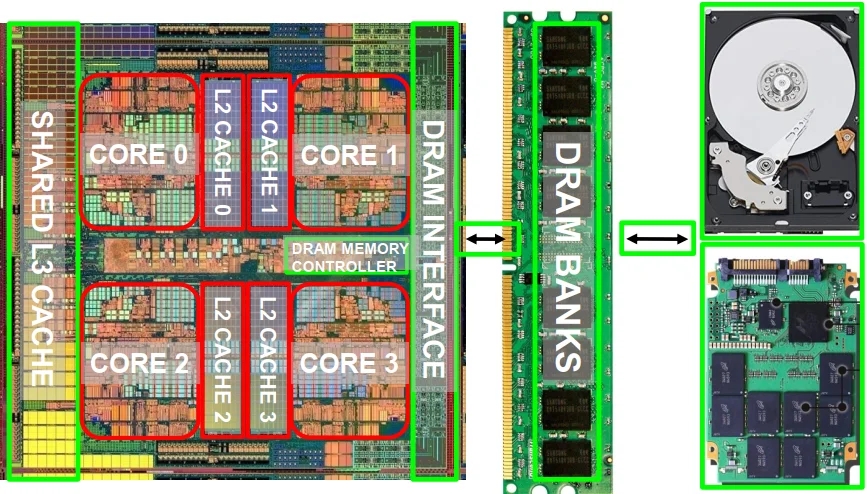
Ideal Memory
Zero access time (latency)
Infinite capacity
Zero cost
Infinite bandwidth (to support multiple accesses in parallel)
Ideal vs Reality
Ideal memory’s requirements oppose each other
Bigger is slower
Bigger -> Takes longer to determine the location
Faster is more expensive
Memory technology: SRAM vs. DRAM vs. Disk vs. Tape
Higher bandwidth is more expensive
Need more banks, more ports, higher frequency, or faster technology
存储技术: DRAM
Dynamic random access memory
Capacitor charge state indicates stored value
Whether the capacitor is charged or discharged indicates storage of 1 or 0
1 capacitor
1 access transistor
Capacitor leaks through the RC path
DRAM cell loses charge over time
DRAM cell needs to be refreshed
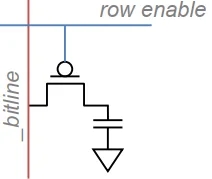
存储技术: SRAM
Static random access memory
Two cross coupled inverters store a single bit
Feedback path enables the stored value to persist in the “cell”
4 transistors for storage
2 transistors for access

注: 图为二维存储阵列. SRAM 和 DRAM 结构基本相同.
Bank Organization & Operation
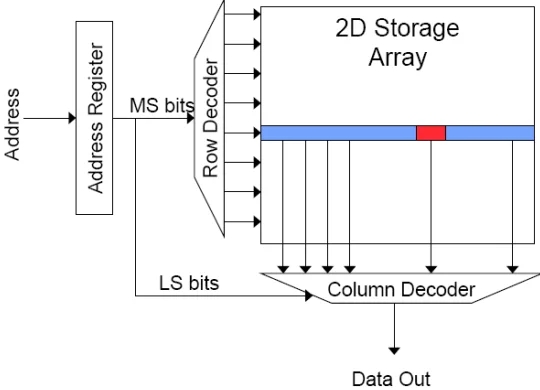
1.Decode row address & drive word-lines
2.Selected bits drive bitlines
Entire row read
3.Amplify row data
4.Decode column address & select subset of row
Send to output
5.Precharge bit-lines
For next access
Static Random Access Memory


Read Sequence
address decode
drive row select
selected bit-cells drive bitlines (entire row is read together)
differential sensing and column select (data is ready)
precharge all bitlines (for next read or write)
Access latency dominated by steps 2 and 3
Cycling time dominated by steps 2, 3 and 5
step 2 proportional to 2m
step 3 and 5 proportional to 2n
Dynamic Random Access Memory

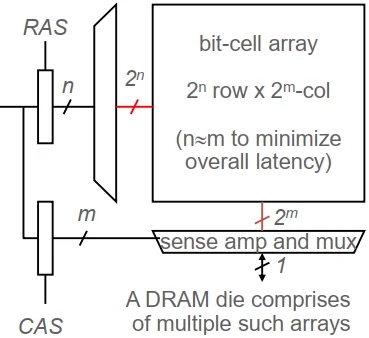
Bits stored as charges on node capacitance (non-restorative)
bit cell loses charge when read
bit cell loses charge over time
Read Sequence
1~3 same as SRAM
4.a “flip-flopping” sense amp amplifies and regenerates the bitline, data bit is mux’ed out
5 same as SRAM
Destructive reads
Charge loss over time
Refresh: A DRAM controller must periodically read each row within the allowed refresh time (10s of ms) such that charge is restored
DRAM vs. SRAM
DRAM
SRAM
Slower access (capacitor)
Faster access (no capacitor)
Higher density (1T-1C cell)
Lower density (6T cell)
Lower cost
Higher cost
Requires refresh (power, performance, circuitry)
No need for refresh
Manufacturing requires putting capacitor and logic together
Manufacturing compatible with logic process (no capacitor)
问题分析
Bigger is slower
SRAM, 512 Bytes, sub-nanosec
SRAM, KByte~MByte, ~nanosec
DRAM, Gigabyte, ~50 nanosec
Hard Disk, Terabyte, ~10 millisec
Faster is more expensive (dollars and chip area)
SRAM, < 10$ per Megabyte
DRAM, < 1$ per Megabyte
Hard Disk < 1$ per Gigabyte
These sample values scale with time
Other technologies have their place as well
Flash memory, PC-RAM, MRAM, RRAM (not mature yet)
Why Memory Hierarchy
We want both fast and large
But we cannot achieve both with a single level of memory
Idea: Have multiple levels of storage
progressively bigger and slower as the levels are farther from the processor
ensure most of the data the processor needs is kept in the fast(er) level(s)
The Memory Hierarchy

Fundamental tradeoff
Fast memory: small
Large memory: slow
Idea:
Memory hierarchyBetter Latency, cost, size, bandwidth tradeoffs
Locality
One’s recent past is a very good predictor of his/her near future.
Temporal Locality: current data or instruction that is being fetched/accessed may be needed soon.
Spatial Locality: instruction or data near to the current memory location that is being fetched, may be needed soon in the near future.
Memory Locality
A “typical” program has a lot of locality in memory references
typical programs are composed of “loops”
Temporal: A program tends to reference the same memory location many times and all within a small window of time
Spatial: A program tends to reference a cluster of memory locations at a time
instruction memory references
array/data structure references
Caching Basics
Idea: Store recently accessed data in
automatically managedfast memory (called cache)Anticipation: the data will be accessed again soon
Temporal locality principle
Recently accessed data will be again accessed in the near futureThis is what Maurice Wilkes had in mind: [Paper]
Wilkes, “
Slave Memories and Dynamic Storage Allocation,” IEEE Trans.on Electronic Computers, 1965.“The use is discussed of a fast core memory of, say 32000 words as a slave to a slower core memory of, say, one million words in such a way that in practical cases the effective access time is nearer that of the fast memory than that of the slow memory.”
Idea: Store addresses adjacent to the recently accessed one in
automatically managedfast memoryLogically divide memory into equal size blocks
Fetch to cache the accessed block in its entirety
Anticipation: nearby data will be accessed soon
Spatial locality principle
Nearby data in memory will be accessed in the near futureE.g., sequential instruction access, array traversal
This is what IBM 360/85 implemented [Product]
16 Kbyte cache with 64 byte blocks
Liptay, “
Structural aspects of the System/360 Model 85 II: the cache,” IBM Systems Journal, 1968.
Caching in a Pipelined Design
The cache needs to be tightly integrated into the pipeline
Ideally, access in 1-cycle, dependent operations do not stall
High frequency pipeline -> Cannot make the cache large
But, we want a large cache AND a pipelined design
Idea:
Cache hierarchy
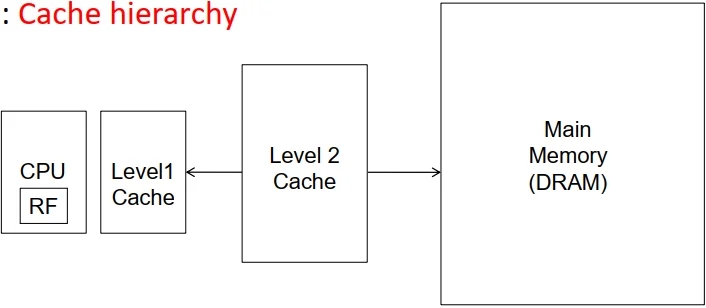
Manual vs. Automatic Management
Manual: Programmer manages data movement across
levels
too painful for programmers on substantial programs
“core” vs “drum” memory in the 50’s
still done in some embedded processors (on-chip scratch pad SRAM in lieu of a cache)
Automatic: Hardware manages data movement across levels, transparently to the programmer
++programmer’s life is easier
the average programmer doesn’t need to know about it
You don’t need to know how big the cache is and how it works to write a “correct” program!
However, what if you want a “fast” program? [Key programmer requirement]
Modern Memory Hierarchy

Hierarchical Latency Analysis
Hierarchical Latency AnalysisFor a given memory hierarchy level i it has a technology-intrinsic access time: ti, The perceived (感知的) access time Ti is longer than ti
Except for the outer-most hierarchy, when looking for a given address there is:
a chance (hit-rate hi) you “hit” and access time is ti
a chance (miss-rate mi) you “miss” and access time ti +Ti+1
hi + mi = 1
Thus:
hi and mi are defined to be the hit-rate and miss-rate of just the references that missed at Li-1
Hierarchy Design Considerations
Hierarchy Design ConsiderationsRecursive latency equation(遞歸延遲方程)
Ti = ti + mi ·Ti+1The goal: achieve desired T1 within allowed costTi ≈ ti is desirable
Keep mi low
increasing capacity Ci lowers mi, but beware of increasing ti
lower mi by smarter management (replacement::anticipate what you don’t need, prefetching::anticipate what you will need)
Keep Ti+1 low
faster lower hierarchies, but beware of increasing cost
introduce intermediate hierarchies as a compromise
Cache Basics and Operation
Cache
Generically, any structure that “memorizes” frequently used results to avoid repeating the long-latency operations required to reproduce the results from scratch
e.g. a web cache
Most commonly in the on-die context: an automatically-managed memory hierarchy based on SRAM
memorize in SRAM the most frequently accessed DRAM memory locations to avoid repeatedly paying for the DRAM access latency
Caching Basics 2
Block (line): Unit of storage in the cache
Memory is logically divided into cache blocks that map to locations in the cache
When data referenced
HIT: If in cache, use cached data instead of accessing memory
MISS: If not in cache, bring block into cache
Some important cache design decisions
Placement: where and how to place/find a block in cache?
Replacement: what data to remove to make room in cache?
Granularity of management: large, small, uniform blocks?
Write policy: what do we do about writes?
Instructions/data: Do we treat them separately?
Cache Abstraction and Metrics
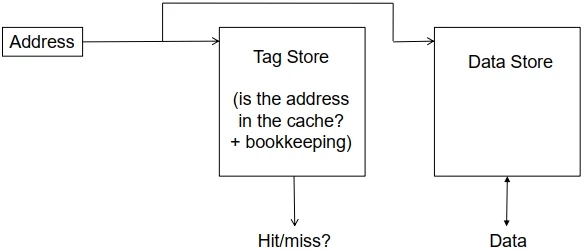
Cache hit rate = (# hits) / (# hits + # misses) = (# hits) / (# accesses)
Average memory access time (AMAT) = ( hit-rate * hit-latency ) + ( miss-rate * miss-latency )
Aside: Can reducing AMAT reduce performance?
Last updated